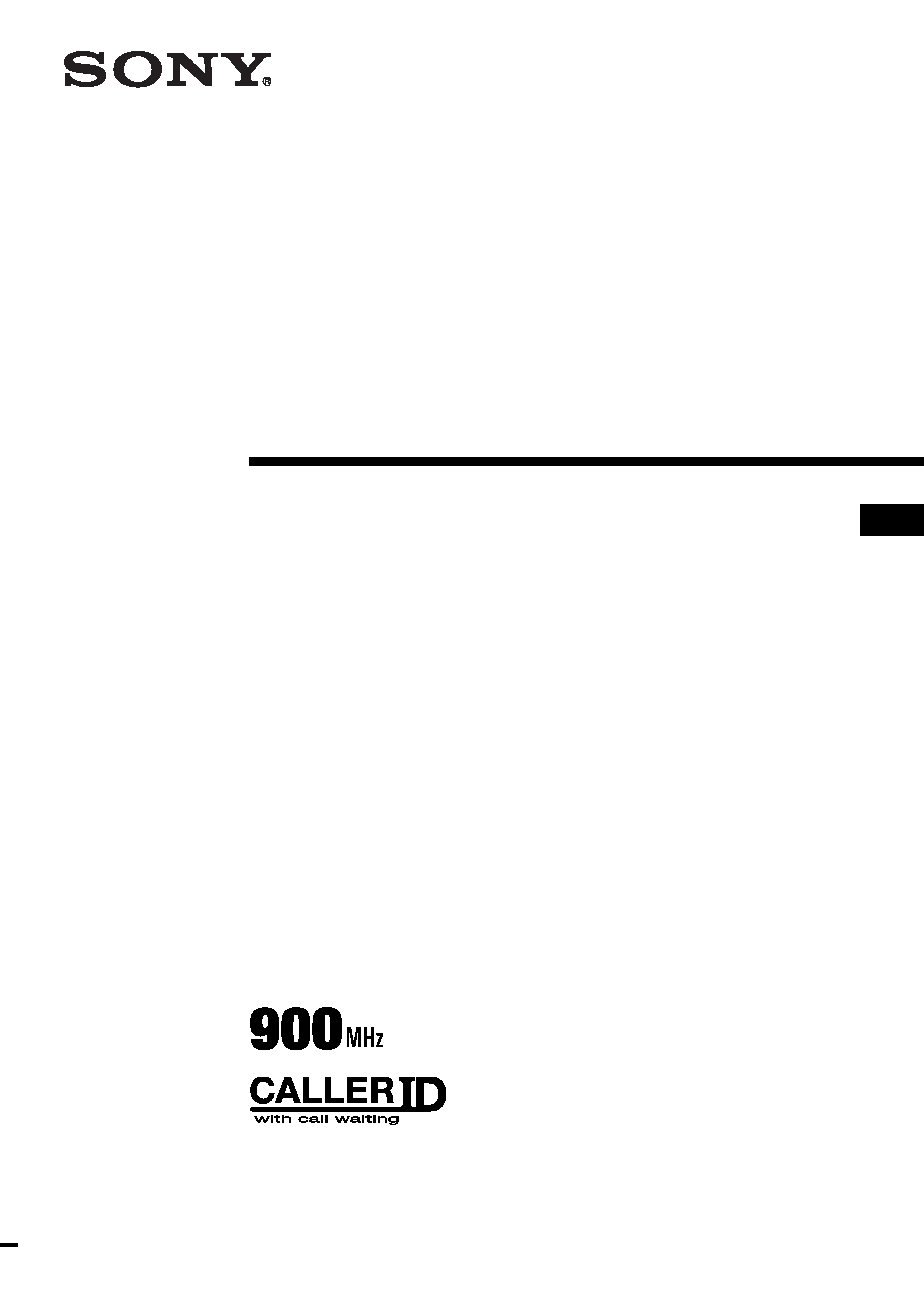
3-230-547-11 (1)
©2001 Sony Corporation
SPP-N1025
Cordless
Telephone
US
Operating Instructions

2
US
Owner's Record
The model and the serial numbers are
located at the bottom of the unit. Record
the serial number in the space provided
below. Refer to these numbers
whenever you call upon your Sony
dealer regarding this product.
Model No. SPP-N1025
Serial No. ________________
IMPORTANT
SAFETY
INSTRUCTIONS
When using your telephone equipment,
basic safety precautions should always
be followed to reduce the risk of fire,
electric shock and injury to persons,
including the following:
1. Do not use this product near water,
for example, near a bath tub, wash
bowl, kitchen sink, or laundry tub, in
a wet basement, or near a swimming
pool.
2. Avoid using a telephone (other than a
cordless type) during an electrical
storm. There may be a remote risk of
electric shock from lightning.
3. Do not use the telephone to report a
gas leak in the vicinity of the leak.
4. Use only the power cord and batteries
indicated in this manual. Do not
dispose of batteries in a fire. They may
explode. Check with local codes for
possible special disposal instructions.
SAVE THESE
INSTRUCTIONS
INFORMATION FOR FCC
REGULATION CLAIM
1. This equipment complies with Part 15 and
Part 68 of the FCC rules for the United States.
On the bottom of this equipment is a label that
contains, among other information, the FCC
certification number and ringer equivalence
number (REN) for this equipment. If
requested, this information must be provided
to the telephone company.
2. This equipment connect to nationwide
telephone network through a modular
telephone jack which applicable certification
jack (connector) is USOC-RJ11C.
3. The FCC compliant telephone cord and
modular plug is provided with this
equipment. This equipment is designed to be
connected to the telephone network or
premises wiring using a compatible modular
jack that is part 68 compliant.
4. The REN is used to determine the quantity of
devices that may be connected to the
telephone line. Excessive RENs on the
telephone line may result in the devices not
ringing in response to an incoming call.
Typically, the sum of the RENs should not
exceed five (5.0).To be certain of the number
of devices that may be connected to a line, as
determined by the total RENs, contact the
local telephone company.
5. If this equipment (SPP-N1025) causes harm to
the telephone network, the telephone
company will notify you in advance that
temporary discontinuance of service may be
required. But if advance notice isn't practical,
the telephone company will notify the
customer as soon as possible. Also, you will
be advised of your right to file a complaint
with the FCC if you believe it is necessary.
6. The telephone company may make changes to
it's facilities, equipment, operations or
procedures that could affect the operation of
the equipment. If this happens the telephone
company will provide advance notice so you
can make the necessary modifications to
maintain uninterrupted service.
7. If trouble is experienced with this equipment
(SPP-N1025), for repair or warranty
information, please contact Sony Direct
Response Center: Tel 1-800-222-7669. If the
equipment is causing harm to the telephone
network, the telephone company may request
that you disconnect the equipment until the
problem is resolved.

3
US
8. All repairs will be performed in an authorized
Sony service station.
9. This equipment may not be used on coin
service provided by the Phone Company or
Party Lines.
10.This equipment is hearing aid compatible.
When programming emergency numbers and
(or) making test calls to emergency numbers:
1. Remain on the line and briefly explain to
the dispatcher the reason for the call.
2. Perform such activities in the off-peak
hours, such as early morning or late
evenings.
Operation is subject to the following two
conditions: (1)This device may not cause
interference, and (2)This device must accept any
interference, including interference that may
cause undesired operation.
Caution
You are cautioned that any changes or
modifications not expressly approved in this
manual could void your authority to operate this
equipment.
Privacy of communications may not be ensured
when using this phone.
Note
This equipment has been tested and found to
comply with the limits for a Class B digital
device, pursuant to Part 15 of the FCC Rules.
These limits are designed to provide reasonable
protection against harmful interference in a
residential installation. This equipment
generates, uses and can radiate radio frequency
energy and, if not installed and used in
accordance with the instructions, may cause
harmful interference to radio communications.
However, there is no guarantee that interference
will not occur in a particular installation. If this
equipment does cause harmful interference to
radio or television reception, which can be
determined by turning the equipment off and
on, the user is encouraged to try to correct the
interference by one or more of the following
measures:
Reorient or relocate the receiving antenna.
Increase the separation between the
equipment and receiver.
Connect the equipment into an outlet on a
circuit different from that to which the
receiver is connected.
Consult the dealer or an experienced radio/
TV technician for help.
IMPORTANTES
INSTRUCCIONES
DE SEGURIDAD
A fin de reducir el riesgo de incendio,
descarga eléctrica y lesiones a las
personas cuando usted use su equipo
telefónico, siempre debe observar
precauciones básicas de seguridad, entre
ellas:
1. No use este producto cerca del agua,
por ejemplo, cerca de una bañera,
lavabo, fregadero de cocina o
lavadora, en un sótano mojado o cerca
de una piscina.
2. Evite usar un teléfono (que no sea del
tipo inalámbricos) durante una
tormenta eléctrica. Existe la remota
posibilidad de shock eléctrico debido
a rayos.
3. Para notificar una fuga de gas, no
utilice el teléfono en la vecindad de
dicha fuga.
4. Utilice solamente el cable de
alimentación y las pilas indicados en
este manual. No tire las pilas al fuego.
Podrían explotar. Compruebe los
códigos locales con respecto a las
instrucciones especiales sobre cómo
deshacerse de ellas.
GUARDE ESTAS
INSTRUCCIONES
INFORMACIÓN PARA LA
DEMANDA DE LA
REGLAMENTACIÓN DE LA
FCC
1. Este equipo cumple con la Parte 15 y la Parte
68 de las reglas de la FCC para EE.UU. En la
base de este equipo hay una etiqueta que
contiene, entre otra información, el número de
certificado de la FCC y el número de
equivalencia de timbre de llamada (REN) para
este equipo. Cuando se solicite, esta
información deberá ofrecerse a la compañía
telefónica.

4
US
2. Este equipo se conecta a la red telefónica
nacional a través de una toma telefónica
modular cuya toma (conector) de certificado
aplicable es USOC-RJ11C.
3. Con este equipo se suministran un cable
telefónico y una clavija modular que cumplen
las normas de la FCC. Este equipo ha sido
diseñado para conectarse a la red telefónica o
la instalación de un usuario utilizando una
toma modular compatible que esté de acuerdo
con la Parte 68.
4. El REN se utiliza para determinar la cantidad
de dispositivos que podrán conectarse a la
línea telefónica. El exceso de REN conectados
a la línea telefónica puede resultar en que los
dispositivos no contesten a llamadas
entrantes. Normalmente, la suma de REN no
deberá ser superior a cinco (5,0). Para
enterarse del número total de REN que puede
conectarse a una línea, póngase en contacto
con la compañía telefónica.
5. Si este equipo (SPP-N1025) produce daños en
la red telefónica, la compañía telefónica le
notificará con antelación que es posible que se
requiera la interrupción temporal del servicio.
Pero si la notificación con antelación no es
práctica, la compañía telefónica lo notificará al
cliente lo antes posible. Además, se le
notificará el derecho a realizar una
reclamación a la FCC si usted lo considera
necesario.
6. La compañía telefónica puede realizar
cambios en sus instalaciones, equipos,
operaciones, o procedimientos que pueden
afectar la operación del equipo. Cuando
suceda esto, la compañía telefónica le avisará
con antelación para que pueda realizar las
modificaciones necesarias a fin de mantener
ininterrumpido el servicio.
7. Si experimenta algún problema con este
equipo (SPP-N1025), con respecto a la
reparación o a la información sobre la
garantía, póngase en contacto con Sony Direct
Response Center: Tel 1-800-222-7669 (EE. UU.
solamente). Si el equipo causa problemas en
la línea, la compañía telefónica puede
solicitarle que desconecte el equipo hasta que
se resuelva el problema.
8. Todas las reparaciones deberá realizarlas un
centro de reparaciones Sony.
9. Este equipo puede no utilizarse en el servicio
de pago previo proporcionado por la
compañía telefónica o la línea compartida.
10. Este equipo es compatible con dispositivos
para ayuda a la audición.
Cuando programe números de emergencia y (o)
realice llamadas de prueba a los mismos:
1. Permanezca poco tiempo en la línea y
explique a la otra parte la razón de la llamada.
2. Realice tales actividades en horas no punta,
como por la mañana temprano o a últimas
horas de la tarde.
La operación está sometida a las dos condiciones
siguientes: (1) Este dispositivo puede no causar
interferencia, y (2) Este dispositivo deberá
aceptar cualquier interferencia, incluyendo la
que pueda causar una operación indeseada.
Precaución
Se le advierte que cualquier cambio o
modificación no aprobado expresamente en el
presente manual podría anular su autorización
para operar este equipo.
El secreto de las comunicaciones puede no
asegurarse cuando utilice este teléfono.
Nota
Este equipo se ha sometido a pruebas y se ha
determinado que cumple los límites para un
aparato digital Clase B de conformidad con la
Parte 15 de las Reglas FCC. Dichos límites están
diseñados para brindar protección razonable
contra interferencia dañina en una instalación
residencial. Este equipo genera, utiliza y puede
radiar energía de radiofrecuencia y, si no se
instala y se usa de acuerdo con las instrucciones,
puede ocasionar interferencia dañina en las
radiocomunicaciones. Sin embargo, no hay
garantía de que no ocurra interferencia en una
instalación específica. En caso de que este equipo
ocasione interferencia dañina en la recepción de
radio o televisión, que se puede determinar
apagando y encendiendo el equipo, se le insta al
usuario a que trate de corregir la interferencia
mediante una o más de las siguientes medidas:
Reorientar o reubicar la antena de recepción.
Aumentar la separación entre el equipo y el
receptor.
Conectar el equipo en un enchufe de un
circuito distinto al circuito al cual está
conectado el receptor.
Consultar con el disstribuidor o con un
técnico experimentado de radio / televisión
para ayuda.

5
US
Table of contents
Getting Started
6
Step 1: Setting up the base phone
9
Step 2: Prepare the battery pack
11
Step 3: Change the display
language
12
Step 4: Choose the dialing mode
13
Step 5: Set the date and time
14
Identifying the parts
Basics
18
Making calls
21
Redialing
22
Receiving calls
Telephone Features
23
One-touch dialing
23
Storing phone number
24
Making calls with one-touch
dialing
25
Speed dialing
25
Storing phone numbers on
the base phone
26
Making calls with speed
dialing on the base phone
27
Phone Directory
27
Storing phone numbers and
names
28
Changing a stored name
and/or phone number
29
Erasing a memory location
30
Making calls from the Phone
Directory
31
Setting the ringer type
31
Turning off the ringer of the
handset
32
Adjusting the ringer volume
level of the base phone
33
Switching the phones during a
call
33
To switch from the base
phone to the handset
34
To switch from the handset
to the base phone
35
Talking between the handset and
the base phone (Intercom)
35
To talk from the handset to
the base phone
36
To talk from the base phone
to the handset
37
Having a three-way conference
37
To join the phone
conversation
Caller ID Features
38
Understanding the Caller ID
service
38
When you receive a call
39
Looking at the Caller ID list
39
Viewing the Caller ID list
40
Erasing data from the Caller
ID list
42
Using the Caller ID list
42
Calling back a number from
the Caller ID list
43
Storing a number of the
Caller ID list into the Phone
Directory
44
To change the number of
digits of the phone number
46
Using "Caller ID with call
waiting" service
47
Using voice mail service
47
If you have messages
Additional Information
49
Mounting the base phone on a
wall
50
Carrying the handset by the belt
clip
52
Notes on power sources
53
Maintenance
54
Troubleshooting
57
Specifications
58
Index
Back cover LIMITED WARRANTY
